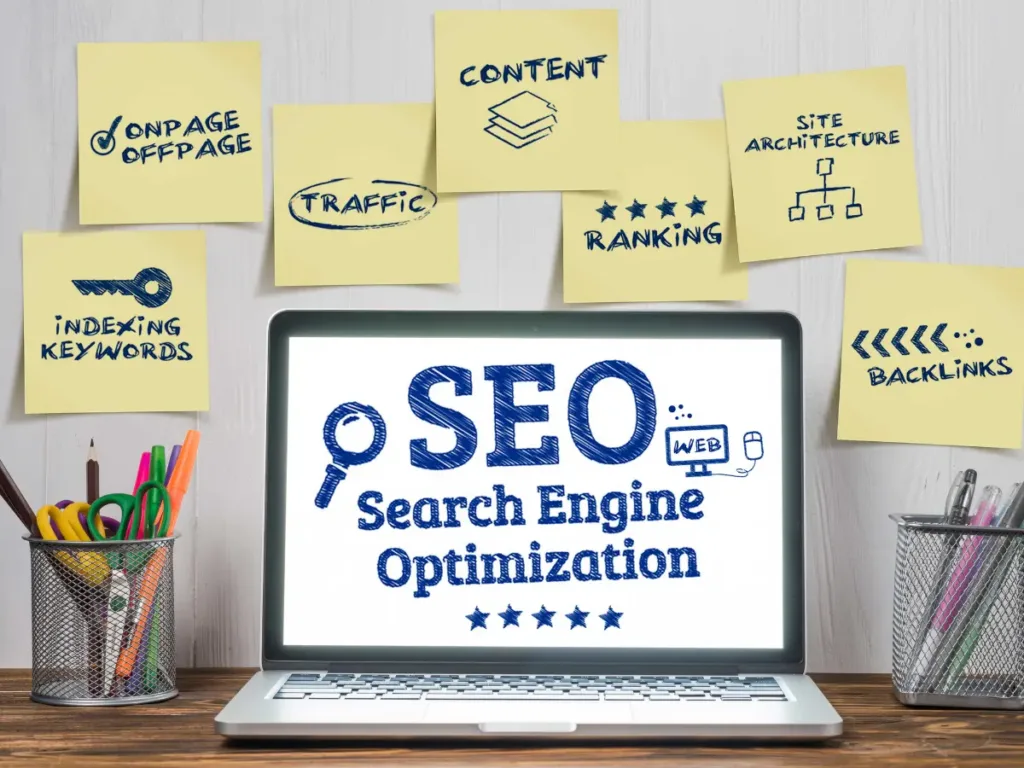
If you’re running an eCommerce business, you’ve probably heard that ranking high on Google can do wonders for your website traffic—and your sales. But how do you actually get there? The answer starts with on-page SEO.
On-page SEO is all about optimizing individual pages on your website to improve their search engine rankings and visibility. It’s the foundation of your SEO strategy and can be the game-changer that gets your store on the first page of search results.
So, if you’ve been wondering why your blog isn’t getting traffic, your digital products aren’t selling, or leads are just not coming in, this guide will walk you through what on-page SEO is, why it matters, and how to nail it.
Read more about SEO for Business Growth.
What is On-Page SEO?
On-page SEO refers to the strategies and techniques applied directly to your web pages to help them rank better in search engines. From optimizing page speed to placing keywords correctly and improving your site’s structure, every tweak you make adds up.
And here’s the deal—over 25% of users click the first result on Google. The further down you go, the less visibility you get. That means if you’re not on page one, you’re basically invisible.
As you can see, if you want to get traffic, you need to be near the top. This is why you have to be on top of your on-page SEO.
If you are wondering why you haven’t been getting leads for your digital services, traffic for your blogging business, or even sales of your digital products, it may be that your on-page SEO needs help.
Let’s look at some more statistics to drive home this point.
Do you know that high-ranking sites have much better click-through rates (CTR)? The first Google mobile search result page has an average organic CTR of 26.9%. 
Read more about SEO for Fashion Ecommerce: How to Let People See Your Brand
Let’s look at some important factors of on-page SEO.
What are the Factors of On-Page SEO?
There are three elements or factors of on-page SEO. Your on-page SEO optimizations should focus on these factors. They are:
- Content
- HTML (your page’s behind-the-scenes code)
- Website Structure
Read more about The Best Ecommerce SEO Company in 2025
Let’s take a closer look at them.

1. Content
Content is the bedrock of on-page SEO optimization. You must have heard the phrase “content is king,” But not just any content—high-quality, keyword-rich, and user-focused content. For your website to rank on the Google search page, you need to have high-quality content and relevant keywords.
Here are some ways to optimize your content for on-page SEO:
a). E-A-T (Expertise, Authoritativeness, Trustworthiness)
E-A-T is a critical aspect of content optimization for on-page SEO. With millions of websites creating content on Google, have you ever asked how Google prioritizes the ones that will appear first?
The truth is that Google looks for content that demonstrates expertise, authoritativeness, and trustworthiness. For instance, when a user searches for medical advice, Google aims to present information from sources with proven expertise and authority in the medical field.
So, how do you demonstrate your expertise, authority, and trustworthiness in your blogging niche, for instance? Good question!
Increasing your E-A-T score is not a day’s job. It requires dedication and a strategic approach.
Google prioritizes content written by experts and trusted sources. For your eCommerce website, that means:
- Using authors who are credible in your industry
- Displaying customer reviews and trust badges
- Getting quality backlinks from industry-relevant websites
- Publishing content backed by data, research, and case studies
b). Keywords Optimization
Your content should match what your audience is searching for. That starts with keyword research. Choose relevant keywords with a good balance of high search volume and low competition. Bonus points if you target long-tail keywords like “best skincare products for oily skin.”
Don’t forget to factor in search intent—is your user looking for information, making a purchase, or comparing options?
Where to place keywords:
-
Page titles
-
Subheadings
-
URL
-
ALT tags for images
-
First 100 words of your content
Just don’t overdo it. Keyword stuffing = bad news for your rankings.
c). SEO Content Writing
This factor of on-page SEO is very important. You have your keywords, it’s time to convert them to content that matters.
Following SEO best practices when creating content is a no-brainer. You cannot just string several keywords on a web page and expect it to rank just like that. There are several things to put in place when creating content.
One, your content must be readable. Users should be able to easily scan your page and find the answers they’re looking for. Most websites use a table of contents to make their content easy to scan.
Do not overuse keywords. Most website owners, in an attempt to rank for a specific keyword, tend to overuse that keyword. This is called keyword stuffing. Remember, keyword cannibalization from earlier? Google frowns on this.
Rather than overusing keywords, you can look for similar keywords or long-tail versions of your keyword. For instance, if you want to rank for the term ‘SaaS business’, you can use ‘SaaS company’, ‘SaaS corporation’, ‘SaaS technology business’, or ‘SaaS products for small businesses’.
Read more about E-commerce SEO Checklist
Keep your sentences and paragraphs short. Long sentences and paragraphs tend to bore readers. This can affect your bounce rate and make readers leave your website faster, sending bad signals to Google.
Distribute subheadings across your content. Subheadings have a way of attracting attention because of their size. You must place keywords in your subheadings as well.
d). Visuals
Visuals – images or videos – are important factors in your on-page SEO techniques. Besides the fact that visual assets make your page less boring and more attractive to your visitors, they also give your SEO a boost.
How? For one, about 36% of consumers use visual search when shopping online. This means that, if done right, optimized images can help you close a deal or make a sale.
Now, when optimizing visuals, you are not just concerned with the ALT texts. You also need to consider the image size and load speed. To prevent slow-loading images, you can convert your images to web formats.
Make sure your images are shareable. This will likely help your backlinking efforts and invariably boost your E-A-T.

2. HTML – HyperText Markup Language
If you don’t have tech skills, you may probably not like this part of on-page SEO. However, optimizing your HTML is equally important if you want to rank on search engine result pages.
HTML is the code used to structure the pages on your website. They are relevant because they send signals to search engines about what your page is about and where you should be ranked.
Let’s look at some on-page SEO HTML factors:
a). Meta Title Tags
Meta title tags are very important when optimizing your on-page SEO. When done together with other on-page SEO elements, title tags can help you build context and show how relevant your site is.
Make sure you craft unique and compelling title tags for each page. As a rule of thumb, include relevant keywords and keep them within the recommended character limit to ensure they display properly in search results.
b). Meta Descriptions
Some SEO experts believe that meta descriptions are irrelevant and do not help your web pages rank. There may be some truth in this, however, meta descriptions help searchers and Google have a better understanding of what your page is about.
It is important to write engaging meta descriptions that accurately summarize the content and encourage users to click through to your site. Although irrelevant to SEO, meta descriptions can increase your CTR.
3. Website Structure
Ensuring your website has a well-organized structure is important. For one, it facilitates search engines’ more effective crawling.
Secondly, it elevates the overall user experience, creating a digital environment that engages and retains visitors.
Read more about Using SEO Marketing to Attract Holiday Shoppers to Your Website
Let’s look at key considerations when optimizing your website’s structure:
a). Site Speed
A sluggish, slow-loading website does more than test the patience of visitors. To be honest, it can adversely impact your search ranking.
To meet current standards, your website must align with Google’s Core Web Vitals minimum threshold. If your site falls short, implementing strategies such as enabling compression, minimizing redirects, optimizing images, and leveraging browser caches can significantly enhance site speed.
b). Responsive Design
Having a responsive website, for both mobile and desktop users, is important. Just so you know, Google adjusted its algorithms to prioritize sites with responsive designs in mobile search rankings.
Yes, you can rank without having a responsive design. However, the user experience for your visitors will be poor. So, you may be getting traffic, but sales conversion may become difficult.
c). URL Structure
Although URLs no longer hold the prominence they once did in SEO rankings, they still contribute to a site’s initial ranking and play a role in overall scoring. While not the top SEO priority, neglecting your URL structure entirely is unwise.
Understanding how URLs factor into Google rankings is essential for maintaining a well-rounded optimization strategy.
A clean URL not only helps with search engine optimization but also signals to users that they’re navigating a well-thought-out website.
Additionally, a well-organized URL structure adds a touch of orderliness, making your brand look good. Visitors, whether consciously or subconsciously, interpret a clean and concise URL as an indicator of a professionally managed website.
Now, this perception can significantly influence their trust and confidence in the information or services you provide. Remember E-A-T? Yes, this will help increase your score.
d). Internal Linking
When it comes to website architecture, internal linking isn’t just about making navigation smooth – it’s about creating a web of interconnected content. Strategically linking relevant pages within your site enhances the user experience.
Visitors can seamlessly explore related content, giving them a sense of coherence and completeness. Moreover, from a user’s perspective, well-placed internal links make your website look well-organized.
From the on-page SEO standpoint, smart internal linking contributes to the fair distribution of credibility across your web pages. It’s a deliberate strategy that underscores your commitment to providing each piece of content with its due share of recognition.
e). Sitemap
An XML sitemap is the blueprint that helps search engines understand the layout of your website. This document plays a vital role in efficiently guiding search engine crawlers through your website, ensuring that every piece of content gets the attention it deserves.
If you’re wondering why your published blog posts or web pages aren’t appearing in search results, it may be because you did not submit your sitemap. Submitting your sitemap simplifies the crawling process. This makes your site more visible in search engine results.
Beyond the technical aspects, a well-constructed XML sitemap signals your commitment to transparency and accessibility. Visitors and search engines alike appreciate the clarity provided by a sitemap.
Read more about Common SEO Mistakes Affecting Your Website and How to Fix Them.
Why On-Page SEO Matters for eCommerce
Let’s be real—most shoppers never scroll past page one. By improving your on-page SEO, you’re not just chasing higher rankings; you’re setting your brand up for more visibility, better click-through rates, and ultimately, more sales.
Whether you’re offering services, selling digital products, or running an online store, on-page SEO can be the push your brand needs to break through.
Read more about On-Page vs. Off-Page SEO
On-Page SEO Example
Let’s look at an example of on-page SEO in action.
|
On-Page SEO Element |
Original |
Optimized |
|
Title Tag |
Delicious Smoothie Recipes |
10 Healthy and Delicious Smoothie Recipes for a Nutrient-Packed Day |
|
Meta Description |
Explore our smoothie recipes for a tasty treat. |
Discover a collection of nutrient-rich and delicious smoothie recipes that will fuel your day. From refreshing green blends to protein-packed options, find the perfect healthy smoothie for you. |
|
URL Structure |
www.example.com/blog/post123 |
www.example.com/healthy-smoothie-recipes |
|
Header Tags |
<h1>Smoothie Delights</h1> |
<h1>10 Healthy and Delicious Smoothie Recipes</h1> <h2>1. Refreshing Summer Bliss Smoothie</h2> |
|
Keyword Optimization |
smoothie recipes |
healthy smoothie recipes, nutrient-packed smoothies, delicious homemade smoothies |
|
Image Alt Text |
Image001.jpg |
Nutrient-packed green smoothie with spinach, banana, and berries |
|
Internal Linking |
For more recipes, click here. |
Explore our other nutritious smoothie recipes, such as the Protein Power Smoothie. |
|
Content Quality |
Brief descriptions of smoothie recipes. |
Comprehensive content with detailed instructions, nutritional information, and personal anecdotes about each smoothie. The content is well-researched, engaging, and provides value to the reader. |
|
Page Load Speed |
Large image files are causing slow loading. |
Compressed images, minimized scripts, and optimized code for faster page load times, ensuring a better user experience. |
|
Mobile Optimization |
Unresponsive design on mobile devices. |
Responsive design, ensuring the smoothie recipes are accessible and visually appealing on various devices, including smartphones and tablets. |
On-Page SEO Checklist
Here’s a sample on-page SEO checklist:
|
On-Page SEO Element |
To-do |
|
Keyword Research |
– Identify relevant keywords – Consider user intent and search volume – Use tools like Google Keyword Planner or other SEO tools |
|
Title Tag |
– Craft a compelling title – Include primary keyword(s) – Keep it under 60 characters |
|
Meta Description |
– Write a concise and engaging description – Include target keywords naturally – Limit to around 150-160 characters |
|
URL Structure |
– Create clean, readable URLs – Include relevant keywords – Avoid special characters and unnecessary parameters |
|
Header Tags (H1, H2, etc.) |
– Use a clear H1 tag for the main title – Organize content with H2, H3, etc., tags – Incorporate keywords naturally |
|
Keyword Optimization |
– Integrate keywords throughout the content – Use keywords in the first paragraph – Avoid keyword stuffing; maintain a natural flow |
|
Image Optimization |
– Use descriptive file names for images – Add alt text with relevant keywords – Compress images for faster loading |
|
Internal Linking |
– Link to relevant internal pages – Use descriptive anchor text – Ensure a logical and user-friendly flow |
|
Content Quality |
– Provide valuable, unique, and well-researched content – Address user queries comprehensively – Aim for a readable and engaging writing style |
|
Page Load Speed |
– Optimize images and multimedia elements – Minimize HTTP requests – Leverage browser caching – Use a Content Delivery Network (CDN) |
|
Mobile Optimization |
– Ensure a responsive design – Test on various devices and browsers – Optimize font size and touch elements for mobile users |
|
URL Canonicalization |
– Choose a preferred URL version (www vs. non-www) – Set up 301 redirects for URL variations – Avoid duplicate content issues |
|
Schema Markup |
– Implement structured data where applicable – Use schema.org vocabulary for rich snippets – Enhance the appearance of search results |
|
Robots.txt |
– Set directives for search engine crawlers – Allow or disallow specific pages – Ensure it doesn’t block essential content |
|
Sitemap |
– Create and submit an XML sitemap – Include all relevant pages – Keep it updated with changes |
|
Page Titles and Descriptions (For Each Page) |
– Customize titles and meta descriptions for each page – Tailor content to the unique focus of each page |
|
Content Formatting |
– Use short paragraphs and bullet points – Include relevant headers and subheaders – Enhance readability with a clear structure |
|
Social Media Integration |
– Include social sharing buttons – Optimize Open Graph meta tags for social previews – Encourage social engagement |
|
User Experience (UX) |
– Ensure a clean and intuitive design – Optimize for easy navigation – Prioritize a positive user experience |
|
SSL Certificate |
– Secure your website with an SSL certificate – Ensure all pages are served over HTTPS |
|
External Links |
– Link to authoritative external sources – Use relevant anchor text – Ensure the credibility of linked sources |
Time to Work
To be honest, even after completing all of these, you still need to be patient. It takes some time to see the results you want.
No marketing strategy works in isolation. When implementing your on-page SEO strategies, make sure you also have a solid off-page SEO game plan – eCommerce email marketing, social media marketing, and even pay-per-click.
Every part of your eCommerce marketing strategy has to be on board. It is important to take advantage of eCommerce marketing tools – let’s face it, how exactly do you want to keep track of backlinks or generate sitemaps without the best SEO tools?
You can get the results you want. But make sure you know when to take a step back and audit what you’ve done.
Need help optimizing your e-commerce website for SEO? Contact us!
Related Marketing Strategies

8 Best CRM for Email Marketing in 2025



